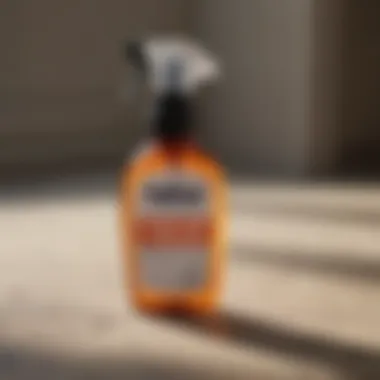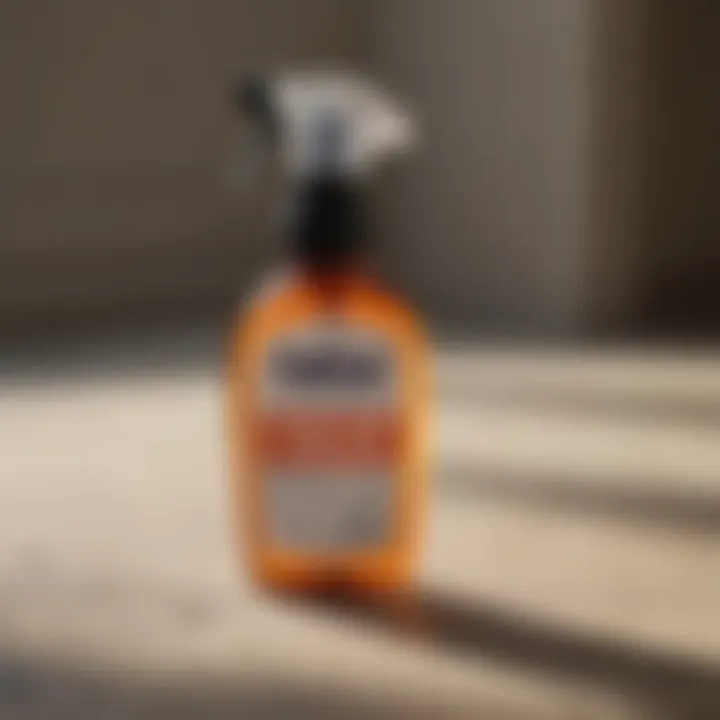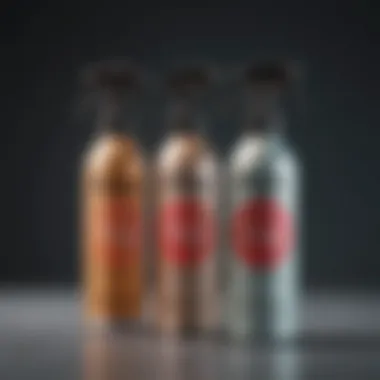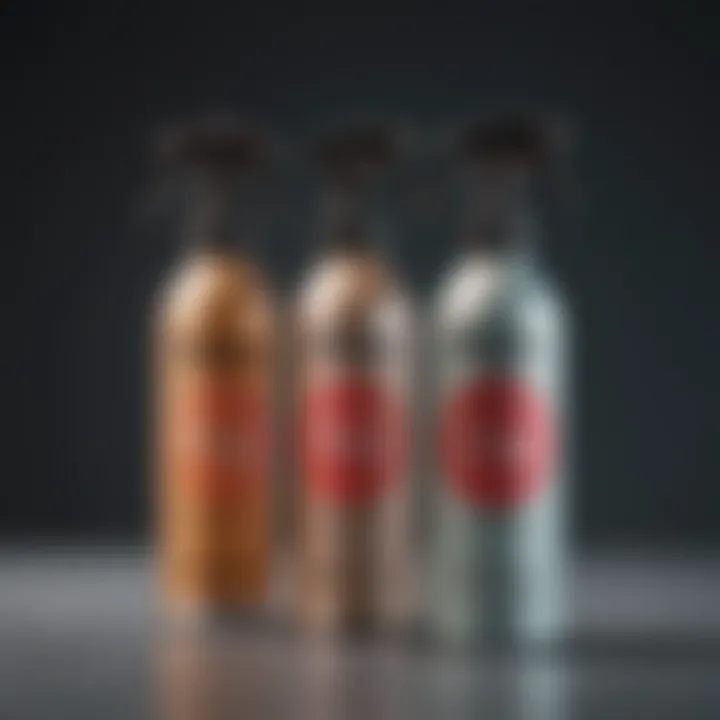Top Flea Spray for Effective Home Pest Control


Intro
Fleas are more than just an annoyance; they can lead to significant discomfort for both pets and humans. Addressing a flea infestation is essential for maintaining a healthy home environment. This article delves into the world of flea sprays, guiding homeowners through the process of selecting the best product for their needs. With an emphasis on safety and effectiveness, we explore various features of flea sprays, their ingredients, and application techniques.
Understanding Pests
Definition of Pests
Pests, in a broader context, refer to organisms that adversely affect human activities, health, or the environment. Fleas specifically belong to the category of ectoparasites, which are parasites living on the outside of their hosts. These tiny insects feed on the blood of mammals and birds, breeding prolificly if not managed effectively.
Importance of Pest Identification
Identifying fleas is critical in any pest management strategy. Fleas can be distinguished by their flattened bodies and long hind legs, allowing them to jump remarkable distances. Correctly identifying the presence of fleas can lead to better treatment options. Recognizing the signs of an infestation, such as flea bites or flea dirt, is vital for timely intervention.
Prevention Techniques
Home and Garden Preventative Measures
Preventing a flea infestation begins within the home. Regular vacuuming of carpets, upholstery, and pet bedding removes both fleas and eggs. Washing pet bedding in hot water at least once a week is another effective tactic. Additionally, treating your garden by maintaining a well-groomed yard can help limit flea populations.
- Remove debris: Clear any leaves, grass, or brush piles where fleas might thrive.
- Use mulch wisely: Coarse mulch discourages flea habitats.
Seasonal Prevention Tips
Flea control is often seasonal, with the risk escalating during warm months. During this period, ensure pets are treated with preventative medications advised by veterinarians. Applying flea sprays to yard areas frequented by pets can deter fleas from entering the home.
Eco-Friendly Pest Control Solutions
Overview of Sustainable Practices
Sustainability is an essential aspect of modern pest control methods. Homeowners are increasingly looking for eco-friendly solutions that are effective yet safe for pets, people, and the environment. Methods include adopting integrated pest management (IPM), which emphasizes long-term prevention through ecological methods without relying solely on chemical sprays.
Natural Remedies and Their Effectiveness
There are several natural remedies that can assist in flea control, albeit typically not as potent as commercial sprays. Essential oils such as lavender and eucalyptus can repel fleas. However, caution should be employed as some essential oils may be toxic to pets. When using natural remedies, always verify their safety for your specific situation.
"Integration of financial, social, and environmental aspects provides a comprehensive approach to flea management."
Prolusion to Flea Infestations
Flea infestations can pose serious challenges for homeowners. Understanding fleas and their behavior is essential for effectively managing these pests. This section discusses the nature of fleas, the signs of infestations, and their impact on living spaces. Fleas are not just an annoyance; they can cause harm to pets and humans alike. Familiarity with the topic allows homeowners to take proactive measures and ensure a pest-free environment.
Understanding Fleas
Fleas are tiny, wingless insects that thrive on the blood of their hosts, which can be pets or humans. These pests belong to the order Siphonaptera. Adult fleas are about 1/16 to 1/8 inch long, making them difficult to spot. Their bodies are flattened laterally, which allows them to move easily through fur or feathers. Fleas cannot fly but are capable of jumping up to 150 times their own body length. They feed mainly at dusk or dawn, making them elusive and hard to capture.
Fleas reproduce rapidly. A female flea can lay hundreds of eggs during her lifetime. The eggs fall off the host into carpets, bedding, and floors. The eggs hatch into larvae that feed on organic debris, primarily the feces of adult fleas, and eventually pupate into adults. This cycle illustrates the importance of addressing flea infestations promptly.
Common Symptoms of Infestations
Identifying flea infestations early can prevent a small problem from escalating. Common symptoms include:
- Pets scratching or biting: Animals may become restless and excessively groom themselves.
- Flea dirt: This appears as small black specks in the fur, which are digested blood and flea excrement.
- Red bites on humans: Individuals may notice itchy spots or welts on their skin.
- Presence of fleas: Spotting fleas jumping on pets or within household environments is a clear sign of an infestation.
- Unusual behavior in pets: Pets may demonstrate signs of anxiety or irritability due to flea bites.
Early detection is critical in controlling infestations and can save pet owners from significant distress.


Impact of Fleas in Homes
Flea infestations can have serious repercussions for households. These pests not only annoy pets but can also transmit diseases. Fleas can lead to conditions such as anemia or skin infections in pets. Additionally, they can be responsible for transmitting tapeworms. The discomfort caused to both pets and humans can create a stressful living environment.
In more severe situations, flea infestations may necessitate professional pest control, leading to additional expenses. Beyond the financial implications, infestations can also result in long-lasting damage to carpets, upholstery, and bedding due to the staining from flea dirt and blood.
In summary, understanding fleas and their effects helps homeowners take the right steps to prevent and manage infestations effectively. It underscores the need for an informed approach when selecting solutions, like flea sprays, to maintain a healthy living space.
Factors to Consider When Selecting Flea Sprays
When it comes to choosing a flea spray for your home, clear understanding of several factors can lead to more effective pest management. Flea infestations can cause discomfort and health issues for both humans and pets. Thus, selecting an appropriate spray becomes essential. Factors that play vital roles include the target audience, active ingredients, safety, and environmental impact.
Target Audience and Use Case
Different users may have varied goals when selecting a flea spray. For instance, homeowners with pets might seek long-lasting solutions that cater specifically to animal safety while also providing immediate relief from fleas. In contrast, individuals who prioritize organic or natural solutions may search for sprays that use essential oils rather than chemicals. Each group's needs will greatly influence the appropriateness of any given product.
Key considerations include:
- Household inhabitants: Consider any allergies or sensitivities among family members or pets.
- Type of infestation: The severity and location of the infestation may determine the needed strength of the spray.
- Frequency of use: Some households may require more frequent application than others based on how often they interact with outdoor pets or high-risk areas.
Active Ingredients and Their Efficacy
The effectiveness of flea sprays primarily relies on their active ingredients. Understanding these ingredients helps in making informed decisions. Commonly used ingredients include Pyrethroids, Insect Growth Regulators (IGRs), and natural extracts. Each of these serves a distinct purpose.
- Pyrethroids: They disrupt the nervous system of the fleas, killing them on contact. They are effective but can be harmful to some beneficial insects, so caution is advised.
- Insect Growth Regulators (IGRs): These prevent flea larvae from developing, effectively breaking the lifecycle. While they do not kill adult fleas, they help in long-term control by preventing future infestations.
- Natural Extracts: Products with essential oils like rosemary or peppermint can repel fleas. Although these alternatives may not always provide the immediate knockdown effect of synthetic chemicals, they offer a safer option for pets and children.
Consider your needs and evaluate what type of ingredients suit your situation best.
Safety Considerations
Safety is paramount. Any flea spray used in the home should pose minimal risk to both inhabitants and pets. Read labels carefully; many products have specific guidelines regarding usage around children or animals.
Important safety tips include:
- Always ventilate the area before and after application.
- Keep pets and children away during and after spraying until the area is dry.
- Look for non-toxic labels or certifications to ensure safety.
Proper understanding of safety measures enhances confidence in choosing the right product.
Environmental Impact
The ecological consequences of pest control products cannot be ignored. Many flea sprays contain chemicals that potentially harm non-target species and disrupt local ecosystems. When selecting a spray, consider its environmental footprint. Look for options that emphasize eco-friendliness and reduced toxicity. Products formulated with natural ingredients often have less adverse impact on your garden and surrounding wildlife.
In the end, making educated choices about flea sprays requires careful consideration of the factors discussed above. By evaluating these elements, you can better ensure that the flea spray you choose aligns with your home’s needs and your personal values.
Popular Flea Spray Brands and Their Effectiveness
Understanding the popular flea spray brands is crucial for homeowners seeking effective pest control solutions. The vast number of options available in the market can overwhelm even the most diligent consumer. Selecting the right brand not only affects how well the product works, but it also influences safety for both humans and pets in the household. Each brand typically has its own unique formula, which may include different active ingredients and varying application methods. Thus, having an informed perspective on these brands enhances one's ability to choose a product tailored to specific needs and circumstances.
Brand A: Overview and Features
Brand A has established itself as a reputable choice among flea sprays. Its formulation combines both immediate killing action and long-term residual effects, which are essential for effective flea control. Users appreciate its ease of use, with a spray nozzle designed for efficient coverage of various surfaces in the home. Additionally, Brand A positions itself as a pet-safe option, ensuring that families can use it without worrying about harm to their furry companions. The spray dries quickly, allowing households to return to normal activities shortly after application.
Brand B: Overview and Features
Brand B offers a distinctive approach by integrating natural ingredients within its formula. This brand has become popular among environmentally-conscious consumers who seek to avoid synthetic chemicals yet still desire effective results against flea infestations. The unique blend of essential oils not only repels fleas but also provides a pleasant scent after application. Another highlight is Brand B’s commitment to sustainability, using recyclable packaging materials which aligns with the values of many modern households. Users often report a high satisfaction rate regarding its effectiveness on various surfaces and in different areas of the home.


Brand C: Overview and Features
Brand C focuses on fast-acting solutions, aiming to eliminate fleas at the first contact. Its unique selling point lies in the use of a potent combination of chemical and non-chemical agents that engage different life stages of fleas. Many customers find satisfaction in the brand's ability to target not just adult fleas but also larvae and eggs, creating a comprehensive solution to flea problems. Furthermore, Brand C emphasizes safety by providing clear application instructions and recommendations for households with children and pets, highlighting their commitment to responsible pest control.
Comparative Analysis of Brands
When comparing Brand A, Brand B, and Brand C, it becomes clear that each has its strengths and weaknesses. Here are some dimensions to consider during evaluation:
- Effectiveness: Brand A excels in rapid knockdown and residual control; Brand B shines as a natural alternative, while Brand C targets all life stages effectively.
- Safety: Brand B leads significantly in terms of natural safety for pets and humans. Brand A is pet-safe, but some users may still prefer natural options. Brand C assures safety but relies on synthetic agents.
- Application: All brands are relatively easy to apply, though Brand A’s nozzle design may offer superior convenience, while Brand B’s natural solution can leave a pleasant smell.
Exploring Active Ingredients in Flea Sprays
Understanding the active ingredients in flea sprays is crucial to selecting an effective product. These components are responsible for the effectiveness of the spray in eliminating fleas and preventing future infestations. Each ingredient has different mechanisms, advantages, and potential drawbacks that homeowners should consider for safe and efficient pest management. Knowing these details can help the target audience—housewives and homeowners—make informed decisions about flea control and ensure their homes are flea-free.
Pyrethroids: Mechanism and Effectiveness
Pyrethroids are synthetic chemicals modeled after pyrethrins, which are natural insecticides derived from chrysanthemum flowers. These compounds primarily disrupt the nervous system of fleas, leading to paralysis and eventual death. The primary advantage of pyrethroids is their rapid action. They can kill adult fleas quickly upon contact.
However, it is important to note that while effective against adult fleas, pyrethroids do not affect the life stages of fleas, such as eggs and larvae. This can lead to re-infestation if the underlying problem is not addressed. Additionally, there are safety considerations. Some humans and pets may experience allergic reactions or irritation from pyrethroids, so caution during application is needed.
Insect Growth Regulators (IGRs)
Insect Growth Regulators, or IGRs, are another class of ingredients commonly found in flea sprays. Their mechanism is distinct from that of pyrethroids. IGRs work by disrupting the development of flea larvae and eggs. When fleas are exposed to IGRs, their growth is inhibited, preventing them from maturing into adults that can reproduce.
The significant benefit of IGRs is their long-lasting effect. They can remain active in the environment and continue to inhibit flea development long after application. This makes them crucial for comprehensive flea control strategies. However, IGRs alone may not eliminate existing adult flea populations, so combining them with other active ingredients can provide optimal results.
Essential Oils: Natural Alternatives
Essential oils are gaining popularity as natural alternatives to traditional insecticides. Ingredients like cedarwood, lavender, and peppermint oils are often touted for their ability to repel fleas. These oils work through various mechanisms, such as disrupting the flea's sensory systems or suffocating them.
Using essential oils can appeal to those who are concerned about chemical exposure. They tend to have fewer side effects on pets and humans but can still be potent in repelling fleas. Nevertheless, essential oils often require multiple applications and may not provide the same immediate results as synthetic chemicals.
"When choosing flea sprays, understanding the active ingredients helps homeowners choose safer, more effective solutions for flea control."
Application Techniques for Optimal Results
Proper application techniques are vital when using flea sprays for optimum results. The effectiveness of these products largely depends on how they are applied. Not just any method will do. Understanding the science behind the application ensures that every inch of your home gets the treatment it needs. Fleas thrive in warm, dark, and hidden areas. Thus, the application should be thorough and systematic to prevent infestation recurrence. Moreover, following proper techniques can enhance safety and efficiency.
Preparation and Safety Steps
Before spraying, careful preparation is essential. First, remove pets and children from the area to avoid exposure to chemicals, even if they are deemed safe for use. Clear other items that can obstruct access to infested areas such as furniture and rugs. This not only improves the reach of the spray but also minimizes the risk of damaging valuable possessions.
Inspect the product label to understand the instructions. Some sprays require shaking before use, or specific distances to maintain during application. Wear gloves and a mask as a precaution, allowing for a safer handling experience by reducing potential inhalation of fumes and contact with skin. It's critical to ensure proper ventilation in the area being treated.
Techniques for Application
When applying flea spray, precision is key. Use the nozzle to target cracks, crevices, and places where fleas may hide, such as under furniture, behind baseboards, and in carpets. Paying attention to these areas increases the likelihood of contact with fleas. Start from the back of the room and work towards the exit to prevent stepping on treated surfaces.
Hold the spray nozzle approximately 12 to 15 inches away from the surface for even distribution. Instead of applying a continuous stream, use short bursts or a sweeping motion to ensure sufficient coverage without saturation. It's best to apply in a methodical manner, so moving systematically helps guarantee no areas are overlooked.
Frequency of Application
The frequency of application is another critical aspect. Most flea sprays recommend reapplication every 7 to 14 days, depending on the product and infestation severity. Monitor the environment after each treatment. If fleas persist, it may indicate that additional measures are necessary, or alternative products could be explored.
Additionally, using an insect growth regulator (IGR) in conjunction with the spray can interrupt the flea life cycle and enhance effectiveness. Consideration should also be given to factors such as seasonal changes, as fleas can re-emerge in warmer months.


"Consistency in application enhances long-term effectiveness against flea infestations."
Post-Application Steps After Using Flea Spray
Once you have applied a flea spray in your house, there are essential steps to take afterward. This process is not just about eliminating the current infestation but also about ensuring that future issues do not arise.
Cleaning and Maintenance
Cleaning is a critical part of the post-application process. After applying a flea spray, it’s important to wait the recommended time before allowing pets or people back into the treated areas. Following this, vacuum your floors thoroughly, focusing on carpets, rugs, and upholstery. Badly infested areas may require more attention.
- Wash Bedding: All pet bedding and your own sheets should be washed at high temperatures. This action eliminates any remaining eggs or fleas.
- Curtains and Upholstery: Consider cleaning curtains and upholstered furniture. Fleas can hide in these areas, so deep cleaning is often a good strategy.
- Regular Maintenance: Establish a regular cleaning schedule to maintain a flea-free environment. Frequenty vacuuming and regular washing of textiles will play a role in prevention.
Monitoring Flea Activity
Monitoring flea activity is a serious aspect of post-application steps. You should check for signs of re-infestation after using flea spray. A few strategies can assist with this:
- Inspect Pets: Use a flea comb to check your pets regularly. If fleas are still present, you may need to repeat the flea treatment.
- Watch for Bites: Monitor your household for bites. Flea bites appear as red, itchy welts on the skin. This may indicate that fleas are active, and additional treatment might be necessary.
- Use Traps: Set flea traps around the home. These traps can help catch any remaining fleas, indicating the level of activity in your living spaces.
Long-Term Flea Prevention Strategies
To avoid future flea problems, consider implementing long-term strategies. After addressing the immediate issue with flea spray, focus on preventative measures:
- Consistent Treatment: Make it a habit to regularly treat both your pets and the environment, particularly during flea season.
- Yard Maintenance: Maintain your yard. Fleas can thrive in the outdoor spaces your pets frequent. Regular lawn care practices can reduce the risk of fleas entering your home.
- Integrated Pest Management (IPM): Adopt an integrated approach to pest management. This could include using natural remedies in conjunction with flea sprays for a more comprehensive strategy.
Proper post-application care can significantly increase the effectiveness of your treatment and reduce the chances of re-infestation.
In summary, taking care of your environment after using flea spray is crucial. Cleaning and maintenance, ongoing monitoring, and long-term prevention create a barrier against fleas, ensuring a healthier living space for you and your family.
Customer Reviews and Feedback
Customer reviews and feedback play a crucial role in the decision-making process for flea sprays. Reviews provide insights that are often absent from product descriptions and marketing language. They allow potential buyers to gauge the real-world effectiveness of a product from individuals who have already used it. In addition, feedback can uncover aspects of a flea spray that may not be highlighted in advertising, such as ease of application or residual efficacy.
Based on user reviews, potential customers can learn about the experiences of others. This is especially beneficial in assessing how well certain flea sprays work in various situations or environments. For instance, a product's performance might vary if applied in a larger home versus a small apartment. Reviews also serve as warnings about possible adverse reactions in pets or children. Therefore, consumers can make an informed choice, balancing effectiveness against safety.
Analyzing User Experiences
When analyzing user experiences, it is important to look for patterns in the feedback. Many reviews will detail specific situations where a product excelled or fell short. For example, one user may commend a flea spray's ability to eliminate fleas quickly, while another might complain about a lingering chemical odor. This feedback can provide insights into the product’s overall effectiveness and user-friendliness.
Additionally, gathering information from a variety of sources, such as forums like Reddit, can help identify common themes. Users might discuss their experiences regarding application techniques or the necessity of using additional products for long-term results. Seeing multiple reviews, both positive and negative, can help create a more balanced view of a flea spray's overall merit.
Effectiveness Based on Feedback
Effectiveness based on feedback is another essential aspect to consider. Reviews often include ratings and detailed descriptions, helping potential buyers identify highly regarded products. For example, a spray that consistently receives high ratings for speed in killing fleas should stand out to someone in urgent need of a solution.
Furthermore, it is beneficial to pay attention to how long the effects last according to customer feedback. Some sprays may eliminate visible fleas but fail to prevent re-infestation. Reviews will often provide detailed accounts of effectiveness over time, offering insight into how well a product performs after initial application.
Finale and Recommendation
In the realm of pest management, flees present a significant challenge within homes. The Conclusion and Recommendation section synthesizes vital information discussed throughout this article, guiding readers through the carefully analyzed aspects of selecting the right flea spray. This part is crucial for homeowners and gardeners who are keen on maintaining a flea-free environment. It emphasizes the importance of understanding product features, effectiveness, safety, and application techniques.
Summary of Key Findings
The investigation into flea sprays has revealed several core findings that consumers should consider:
- Efficacy of Different Ingredients: Various active ingredients, including Pyrethroids, Insect Growth Regulators, and essential oils have different levels of effectiveness. Understanding these will aid in making an informed choice.
- Safety Considerations: It is paramount to prioritize safety for both humans and pets when selecting a flea spray. Certain chemicals can pose risks if not handled properly.
- User Experiences: Customer feedback plays a significant role in understanding real-world effectiveness. Brands like Advantix and Frontline consistently receive high ratings for performance.
- Environmental Awareness: Selecting flea sprays that minimize environmental impact is crucial. Some products offer natural alternatives that are safer for ecosystems.
Final Thoughts on Selecting Flea Spray
When it comes to selecting flea spray, a thoughtful approach is necessary. It is fundamental to match the chosen product to individual needs, whether one is dealing with a minor issue or a full-blown infestation. Additionally, ongoing maintenance and monitoring are essential aspects of long-term flea control. Applying the right spray at the right intervals can save homeowners larger expenses and health concerns down the road. Overall, attention to detail in the selection process will yield the best outcomes in achieving a flea-free household.
A well-informed choice can transform your home into a refuge, free from the nuisance of fleas.



